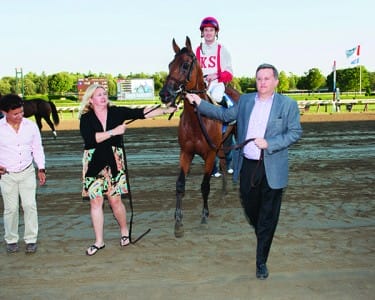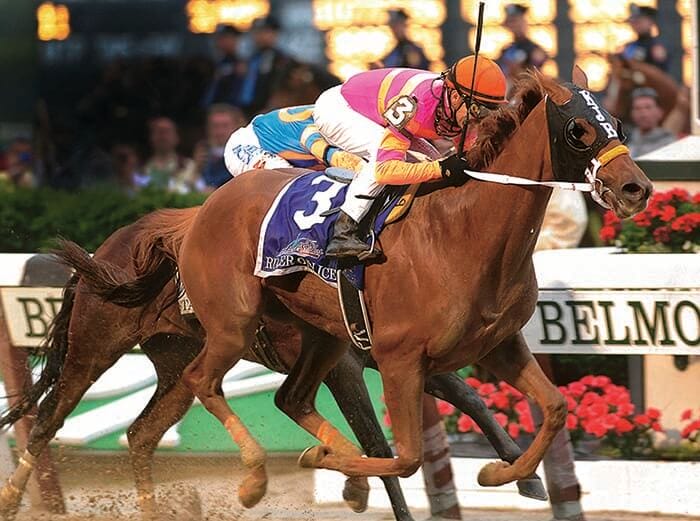William Lawrence, W’83, grew up in the shadow of the legendary Saratoga Race Course, which meant that, inevitably, he grew up with horse racing too.
Racing is the lifeblood of Saratoga Springs, NY, and Lawrence says he and his friends loved the sport so much they promised each other that, should any of them end up with the means to do so, they would one day buy horses of their own.
A few decades later, after Lawrence made his fortune as founder and CEO of Meridian Capital Partners, his friends made it a point to remind him of their childhood pledge. They didn’t have the money. But he did.
“They said, ‘Well, you’re the guy,’” Lawrence says.

George Hall’s Ruler on Ice in action
He was true to his word. He bought some horses and then a few more, and, today, he’s living his childhood dream. In his partnership with investment guru Seth Klarman, Lawrence owns about 100 horses. Lawrence has seen his horses run in and win some of the biggest races in the country, and he says he’s loved every minute of his involvement in the sport he grew up with.
But he is also brutally honest about one thing: From a strictly business point of view, horse racing isn’t a very good business at all. In fact, it’s a pretty lousy one.
“If you find people who are actually making money in this sport, then please let me know,” Lawrence jokes. “For me, being from Wharton, for Seth, who is a great investor, this business is very incongruous to how we would normally think otherwise.”

William Lawrence and his wife Gloria with Balance the Books at Saratoga
There’s simply no escaping it: Horse racing is expensive, challenging, risky and, more often than not, entirely unprofitable. It takes a lot of money to buy horses, and it takes even more to train and care for them. Less than half of the young horses bought every year will ever set foot on a race track, and the odds of winning any race, much less a big one, are pretty slim.
Given the sport’s inherent financial flaws, it’s remarkable that Lawrence isn’t the only Wharton alum brave enough to compete in it. But he’s not. George Hall, WG’86, who, like Lawrence, grew up near Saratoga, has been involved in the sport since 2004.
Hall agrees that the sport is probably more of an expensive pursuit than a stable business, but he also agrees that there simply isn’t any thrill like seeing your horse win a big race. That, he says, makes all the trouble worth it.
“When I first got involved, I had somebody tell me that two out every three horses you buy might never even get to race,” says Hall, president and founder of the investment firm The Clinton Group. “They might not be good enough. They might not run well enough. They might not ever step foot on the track. But I wanted to race, and I was willing to lose money. We went into this knowing … that we might lose our investment.”
Fortunately for Hall, things have gone better than he probably could have expected.
Of the first four horses he bought in 2004 (at $180,000 for all), two turned out to be big winners, with Keeneland Kat winning the Sorority Stakes in 2005 and Fagan’s Legacy taking the Pilgrim Stakes at Belmont that same year. Since then, he’s purchased dozens more horses, seen two of them run in the Kentucky Derby and now runs his own breeding operation too.
He’s looking excitedly ahead to the new season and believes his best horse, a three-year-old by the name of Bern Identity, is on the cusp of a breakthrough. The horse came into the year having already won $616,000, including the $300,000 Sanford Stakes at Saratoga last July, and could end up making a run at Hall’s ultimate goal: the Kentucky Derby.
“It is the most spectacular sporting event there is, from the fans to the excitement to the international coverage,” Hall says. “Every year around November, people in horse racing start to get what we call ‘Derby fever.’ We’re all figuring out what races we’re going to run to get our horses into the Derby. Once you’re there—and we were lucky to get there [in 2011] because we got there statistically sooner than we should have—all you want is to go back.”
For Lawrence, the Derby isn’t the only race. That’s why Lawrence says he takes a decidedly pragmatic approach to the sport. Heading into each season, he doesn’t just target the Derby, or the Preakness, or the Belmont. He targets all the money races—the “graded stakes,” as they’re known—and tries to figure out how to win as many races as possible.
His strategy has worked. Last year, his stable was among the biggest earners in the sport, and his horses racked up five wins in graded stakes.
“The Derby is a bit of a crapshoot. It’s a tough race, and the horses that run the Derby don’t tend to do well after that,” he says. “One of our horses, Currency Swap, could have run the Derby, but that would have been a setback for the rest of the season. It’s not just the Derby you’re after; it’s the graded stakes, and the real goal is to be winning some of those bigger races.”
Now several years into their racing adventures, both Hall and Lawrence say they are confident in their approach and content with their performances so far. Both have done better than most in the sport, and both have been able to hold the line financially despite the costs they face.
But they also admit that racing has seen better days and say they believe changes need to be made if the racing industry is going to survive and thrive going forward. The sport is having trouble attracting young fans. Lawrence believes many young people, accustomed to “instant everything,” don’t have the patience to wait 30 minutes between each race. It’s also harder than ever to sell tickets because gamblers now have so many other legal options.
“Fifty years ago, this was the only way you could gamble,” Lawrence says. “You’d have huge crowds at the race track. Today, if you go to Hong Kong, you’ll still see huge crowds, but here in the U.S. you don’t because you have a casino in every state. You also have the lottery. There are just a lot more outlets for the gambling dollar.”
“The industry probably expanded too much,” Hall adds. “There are too many tracks and too many races, and we need to be more competitive to get the bettor’s dollars. We haven’t done a good job of marketing either.”
Despite the challenges, both Lawrence and Hall say there is some good news, and that news is this: The biggest races still pay big money, and for them, that’s enough to keep them going. The price to compete may be steep, they say. But the thrill of winning is priceless.
“Winning a horse race,” Lawrence says, “is one of the greatest feelings in the world.”

























